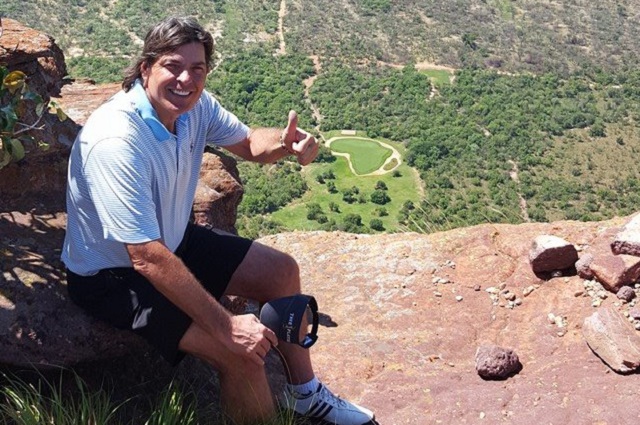CLICK here for Video Interview with Felipe Garcia Moreno, historian of CC of Mexico City.
CLICK here for Video Interview with Ampi Diaz, my host at CC of Mexico City.
CLICK here for Video Interview with Carlos Martinez, Head Golf Professional at CC of Mexico City.
More videos, pictures, & posts coming… what would you like me to write about?
HISTORY (from the club’s website):
When the San Pedro Golf Club, golfing first installation Mexico City , recognizes that it is time to create a club of other dimensions , the Committee appointed to find a suitable terrero , recommended to buy a dairy farm called ” The Nativity ” located in Churubusco. That was how the October 4, 1905 passed away on San Pedro Golf Club and Country Club emerged Mexico . With a golf course designed by the first career Willy Smith .
Undoubtedly , having hired British architect Grove Johnson for construction of the house, was a success , as the original Club House was a style icon and sobriety contributed to our institution .
The Mexican Revolution affected the club in various ways. Periodically, the facility was destroyed during the bombing or occupied by revolutionary factions . At the end of the revolution , Harry Wright urged members to return to the club and led the reconstruction and reorganization of this .
After reconstruction and throughout the next quarter century club presidency was assumed by Harry Wright .
By the Thirties , there was an increase in the number of Mexican partners and above all, had a growing influence society , volunteered dances such as the White and Black frequented by politicians , diplomats , actors and journalists.
Later, in 1945, changes the structure of the club , being constituted as ” Country Club Mexico City .”
Club Campestre de la Ciudad de Mexico
Course Designer Marcelino Moreno
1902 – the oldest course in the country
Harry B. Wright Collection
Harry B. (Bernard) Wright (1897-1958), an orthodontist practicing in Philadelphia, was also a passionate traveler and amateur filmmaker. A member of the Explorer’s Club in New York City, Dr. Wright also wrote a book based on his travels, A Witness to Witchcraft (1957), which was originally to be titled My Colleague, the Witch Doctor. Dr. Wright traveled to and made 16mm films in several countries, in Latin America, West Africa, and Oceania (New Guinea). One produced film, some elements of which we may have in our collection, was called Savages in Paradise (1954), and took place in Papua New Guinea. We do not seem to have a complete print of this film or know where another print exists. Dr. Wright does not seem to have consulted with anthropologists or area specialists in his investigations outside of his own culture. Several of his films have voyeuristic aspects and might be viewed with this concern in mind.
It can be noted that there was another Harry Wright making amateur travelogue films at the same time, whose films can be found at the Library of Congress. Thanks to research by Magdalena Acosta of the Mexican Film Archives we have distinguished the two creators, her emphasis on the latter reveals him to be an American living mostly in Mexico City, note also that the latter Harry Wright had no middle name.
Click here for That Mexican Holiday original film by Dr. Harry B. Wright
In 1904, Willie Smith moved to Mexico City to become the golf pro at the Mexico City Country Club. He was injured during the Mexican Revolution. He had refused to leave his post at the country club and was found trapped under a fallen beam after Emiliano Zapata’s troops ransacked the club which they saw as a symbol of the corrupt ruling class. He later died of pneumonia. His body was returned to Scotland for burial in the family plot.
He became professional at the Mexico City Country Club in 1904 (which brother Alec helped re-design in 1907) and survived Zapata’s forces shelling and ransacking the club in 1914-1915 but died in Mexico the following year of pneumonia.
Emiliano Zapata was a leading figure in the Mexican Revolution. He is considered one of the national heroes of Mexico: towns, streets and housing developments named “Emiliano Zapata” are common across the country. His image has been used on Mexican banknotes. People have long taken different sides on their evaluation of Zapata and his followers: some considered them bandits, but to others they were true revolutionaries who worked for the peasants. Presidents Porfirio Díaz and Venustiano Carranza called Zapata a womanizer, barbarian, terrorist and bandit. Conservative media nicknamed Zapata “The Attila of the South”.
Many peasants and indigenous Mexicans admired Zapata as a practical revolutionary whose populist battle cry, “Tierra y Libertad” (Land and Liberty), was spelled out in the Plan de Ayala for land reform. He fought for political and economic emancipation of the peasants in southern Mexico. Zapata’s trademark saying was, “It’s better to die on your feet than to live on your knees.” Zapata was killed in 1919 by Gen. Pablo González and his aide, Col. Jesús Guajardo, in an elaborate ambush. Guajardo set up the meeting under the pretext of wanting to defect to Zapata’s side. At the meeting, Gonzalez’s men assassinated Zapata.











































Speak Your Mind